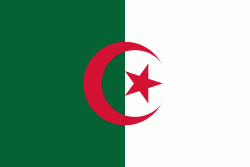Bir el Ater (Bir el Ater)
Bir el Ater (بئر العاتر) is a city located in far eastern Algeria. It is located towards the border with Tunisia, around 87 kilometers south of Tebessa and just beyond the Sahara. The town has a population of approximately 80,000 inhabitants.
Bir el Ater is the type site of the Paleolithic Aterian industry. The term Aterian derives from el-Ater. This lithic culture lasted between 40000 – 20000 years BC.
It is now a mining city, located 15 km south of Bir El Ater. There are deposits of Djebel Onk Phosphates, the largest in Algeria which are extracted and shipped by train to Annaba a port, 300 km north on the Mediterranean or are used locally.
To the north of Bir el-Ater is a plain. Agriculture was flourishing at the time of the Romans. Nowadays, the soil is dry and not very fertile. Vegetation consists essentially of tufts of alfa. To the south lies the Jebel Onk, north-east south-west, it is home to phosphates mines.
The landscape becomes more rugged with few peaks and wadis including many canyons in the yellow ocher. Continuing towards Negrine, the vegetation becomes increasingly rare and the ground is made of white clay and pebbles.
Bir el Ater is the type site of the Paleolithic Aterian industry. The term Aterian derives from el-Ater. This lithic culture lasted between 40000 – 20000 years BC.
It is now a mining city, located 15 km south of Bir El Ater. There are deposits of Djebel Onk Phosphates, the largest in Algeria which are extracted and shipped by train to Annaba a port, 300 km north on the Mediterranean or are used locally.
To the north of Bir el-Ater is a plain. Agriculture was flourishing at the time of the Romans. Nowadays, the soil is dry and not very fertile. Vegetation consists essentially of tufts of alfa. To the south lies the Jebel Onk, north-east south-west, it is home to phosphates mines.
The landscape becomes more rugged with few peaks and wadis including many canyons in the yellow ocher. Continuing towards Negrine, the vegetation becomes increasingly rare and the ground is made of white clay and pebbles.
Map - Bir el Ater (Bir el Ater)
Map
Country - Algeria
 |
|
| Flag of Algeria | |
Algeria produced and is linked to many civilizations, empires and dynasties, including ancient Numidians, Phoenicians, Carthaginians, Romans, Vandals, Byzantines, Umayyads, Abbasids, Rustamids, Idrisids, Aghlabids, Fatimids, Zirids, Hammadids, Almoravids, Almohads, Zayyanids, Spaniards, Ottomans and the French colonial empire, with the latter expanded into its present-boundaries. After 132 years of being part of France, tensions between France and the local Algerian populace led to the start of the Algerian War which concluded with Algeria obtaining its independence on 5 July 1962 with the establishment of the People's Democratic Republic on 20 September of that year.
Currency / Language
| ISO | Currency | Symbol | Significant figures |
|---|---|---|---|
| DZD | Algerian dinar | دج | 2 |
| ISO | Language |
|---|---|
| AR | Arabic language |















